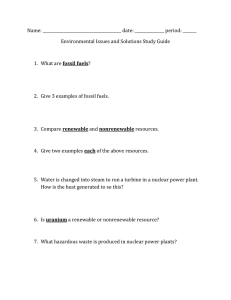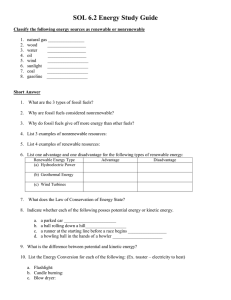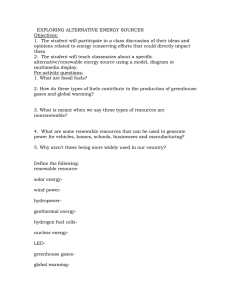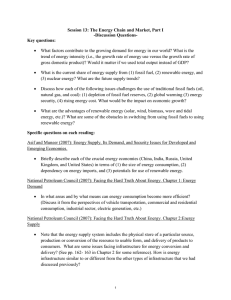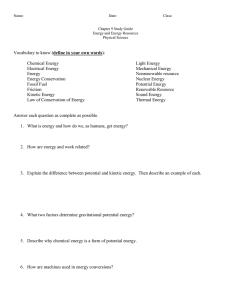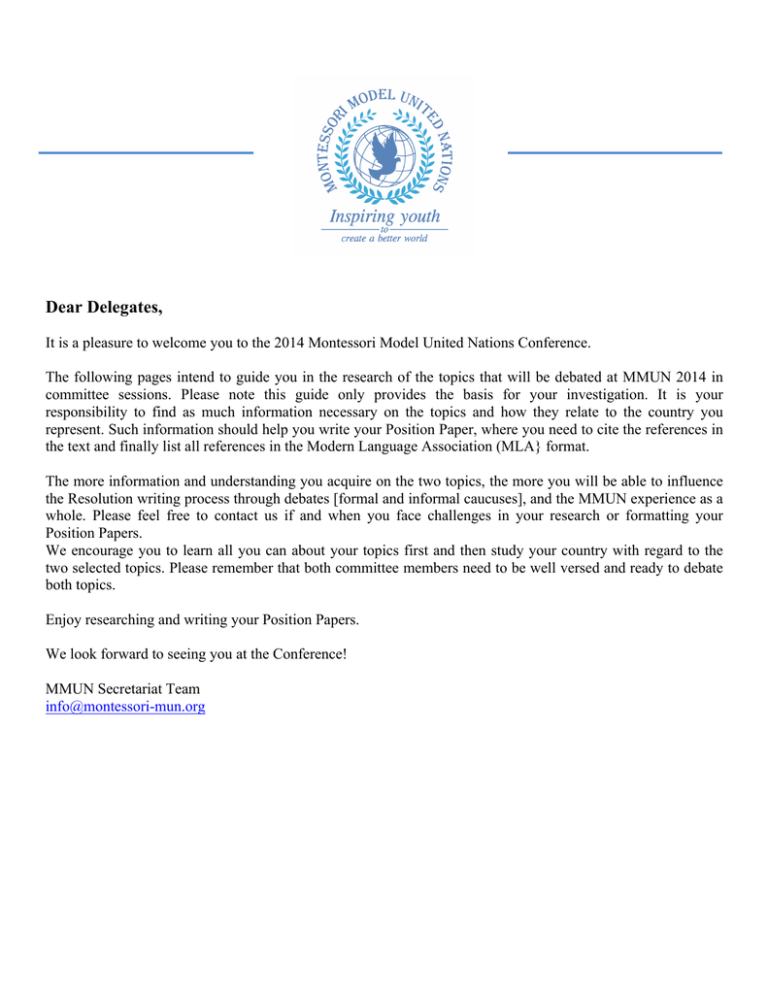
Dear Delegates,
It is a pleasure to welcome you to the 2014 Montessori Model United Nations Conference.
The following pages intend to guide you in the research of the topics that will be debated at MMUN 2014 in
committee sessions. Please note this guide only provides the basis for your investigation. It is your
responsibility to find as much information necessary on the topics and how they relate to the country you
represent. Such information should help you write your Position Paper, where you need to cite the references in
the text and finally list all references in the Modern Language Association (MLA} format.
The more information and understanding you acquire on the two topics, the more you will be able to influence
the Resolution writing process through debates [formal and informal caucuses], and the MMUN experience as a
whole. Please feel free to contact us if and when you face challenges in your research or formatting your
Position Papers.
We encourage you to learn all you can about your topics first and then study your country with regard to the
two selected topics. Please remember that both committee members need to be well versed and ready to debate
both topics.
Enjoy researching and writing your Position Papers.
We look forward to seeing you at the Conference!
MMUN Secretariat Team
info@montessori-mun.org
COMMISSION ON SUSTAINABLE DEVELOPMENT
(CSD)
The United Nations Commission on Sustainable Development (CSD) was established
by the UN General Assembly in December 1992 to ensure effective follow-up of
United Nations Conference on Environment and Development (UNCED), also known
as the Earth Summit. From its inception, the CSD was highly participatory in
structure and outlook, by engaging in its formal proceedings a wide range of official
stakeholders and partners through innovative formulae.
At its eleventh session in 2003, the Commission decided on a multi-year work programme consisting of review
and policy years. Since its establishment in 1992, the Commission has greatly advanced the sustainable
development agenda within the international community.
Source: http://sustainabledevelopment.un.org/csd.html
©Montessori Model United Nations. All rights reserved.
Website: www.montessori-mun.org
Email: info@montessori-mun.org
Renewable Energy
Topic Background
Climate change and its negative affects has become an ever-increasing issue. Many countries are looking for
different energy sources that would cause less environmental damage. Currently most of the energy being used
now is fossil fuels such as petroleum and coal. Fossil fuels are formed from the natural decay of organic
material such as plants or animals. Fossil fuels are considered a nonrenewable resource because they take
millions of years to be created. They have a negative impact on the environment because when fossil fuels are
burned they produce gases. These gases can become trapped in the earth’s atmosphere and do not allow the
sun’s energy to escape from the atmosphere. This is causing the earth to warm and causes harmful
environmental affects and health affects for people.i
The current methods of producing, refining and utilizing energy have negative impacts on the environment. Not
only does the burning of fossil fuels damage the environment, but it can also cause serious health problems for
people. Coal is often burned as part of the process in producing electricity. The gases that are released when the
coal is burned enter the atmosphere as air pollution, which can damage to people’s heath by causing respiratory
issues such as asthma.ii
Renewable energy is a sustainable alternative to the fossil fuels that are being used, without the negative impact
on the environment. Renewable energy can be used immediately, like with solar or wind power, and they also
does not run out. The world relies heavily on fossil fuels, to power cars, heat homes, and many other uses.
However the earth’s supply of fossil fuels is rapidly diminishing as demand continues to increase. Possible
alternatives to fossil fuels are solar power, hydropower, tidal power, wind power, geothermal energy and
nuclear energy, though it is a controversial form of power. These types of renewable energies are non-pollutants
and replenishable making them a better option than the fossil fuels currently being used.iii
Many countries have begun to utilize alternative energies, though the conversion from fossil fuels to alternative
energies is slow:
•
The United States still gets approximately 82% of its energy from fossil fuels. Since 2011 the U.S. is
making strides to use more alternative energy with 11.7% of its energy coming from an alternate energy
source. In 2009, President Barack Obama called for the doubling in use of renewable energy in the next
three years and in his 2012 State of the Union Address the President reaffirmed his commitment to
renewable energy. The U.S. also has multiple government agencies that monitor the environment; its effect
and use of renewable resources such as the Environmental Protection Agency (EPA), The Department of
Energy (DOE), Natural Resources Conservation Service (NRCS), and many others.
©Montessori Model United Nations. All rights reserved.
Website: www.montessori-mun.org
Email: info@montessori-mun.org
•
Brazil, which is considered a developing country, is one of the leading examples of
a developing country using renewable energy rather than fossil fuels. 85.4% of all
of Brazil’s energy comes from renewable resources, particularly sugarcane ethanol which the country has in
abundance. After an oil shortage in the 1970s Brazil focused on developing renewable energies, which is the
reason behind their advanced use of these energy sources.
•
The People’s Republic of China is rapidly developing its use of renewable energy. China has begun to
invest more capital in its renewable energy program during the 2000s focusing specifically on hydropower
and nuclear power. Though China does still mine and use coal for energy and the environmental recovery
from that has been very slow.
There are grave international consequences if the world does not begin to move away from fossil fuels and
increase its use of alternative energies. The greatest threat that fossil fuels pose is to the environment. Global
warming is an important issue that cannot be ignored. If something is not done to slow and stop the greenhouse
by 80% effect people can expect to see an increase in unusual and strong weather patterns such as hurricanes
and droughts, the spread of disease, the rising of sea levels, an increase in temperature, and the depletion of
natural resources. This is an issue that affects the entire world and can prove very dangerous is something is not
done by the international community to address it and makes strides toward solving the issue.
Past International Action
The United Nations Environment Programme (UNEP) is a U.N. body that focuses on promoting the
environment, providing environmental program assistance to developing nations, issues reports on a wide range
of environmental issues, and works to create international conventions and protocols that protect the
environment.
The United Nations Framework Convention on Climate Change (UNFCCC) states that the environment is a
resource utilized by all nations and it is the responsibility of each nation to protect it. The convention was
introduced in 1992 and came into effect on March 21, 1994, when it was ratified by a majority of member
states. The convention specified that governments should work together to minimize the environmental damage
caused by fossil fuels and look for alternative energy sources. Importantly, the convention also pressured
developed nations to reduce their own emissions, as developed countries cause the majority of greenhouse gas
emissions. Although many member states ratified (UNFCCC) the convention was not being upheld to the fullest
and air pollution continues.iv
©Montessori Model United Nations. All rights reserved.
Website: www.montessori-mun.org
Email: info@montessori-mun.org
On December 11, 1997, the Kyoto Protocol was introduced. The Kyoto Protocol is an
amendment to UNFCCC, which includes legally binding environmental goals for
countries to meet from 2008-2012. If the member states meet the requirement, it would
cut greenhouse gas emissions by 5% from the 1990 level. The Kyoto Protocol also included emissions trading.
This allows countries that have surpassed their emission allotment to purchase emission credit from countries
that stay below their limits. Emissions trading allows for underdeveloped countries to benefit financially from
cutting their emissions.v However the Kyoto Protocol has run into some issues, as the United States, and China,
which are amongst world’s largest users of fossil fuels will not sign on to the Protocol which diminishes the
legitimacy of the protocol in many nations’ eyes.
There are multiple governmental and non-governmental organizations that are working toward employing more
environmentally friendly renewable energies versus the fossil fuels currently being used. The United Nations
Environment Programme (UNEP) is an example of such an organization.vi The UNEP’s Risoe Center on
Energy Climate and Sustainable Development (URC) works, particularly with developing nations, to promote
the development and use of renewable energies.
One current nongovernmental organization that focuses on renewable energy is the Renewable Energy Agency
(REA). The REA was founded in 2003 with the goal of protecting the environment by using renewable
energies, informing the public on the use of renewable resources, and promote research on the issue. REA
works with international organizations and governments to promote the research and implementation of
renewable energy. REA is currently working on the study of the potential of anaerobic digestion technologies
implementation in agriculture of Ukraine with US EPA Assistance, A Landfill Gas Feasibility Study and
Collection System and Flare Installation at The Rivne Landfill, Publishes the Ukrainian magazine “Green
Energy,” and has multiple other projects. vii
Possible Solutions
There are many areas where the United Nations can promote the development of renewable energy:
•
Solar and Wind: India, for example, is rated the top producer of solar energy in the world. A third of
India’s energy comes from renewable sources.viii In Brazil, wind power is one of the fastest growing
sources of energy. Although the costs of renewable energy are rising, the government remains
committed to developing wind power and other sources of renewable energy.ix
•
Hydropower: The country of Zimbabwe built mini-hydropower plants to provide energy for citizens
living in rural areas, resulting in less environmental degradation.x The Republic of Korea is building
tidal power plants all along its coasts. The country is investing more than $1 billion over the next couple
years to build plants.xi
©Montessori Model United Nations. All rights reserved.
Website: www.montessori-mun.org
Email: info@montessori-mun.org
•
Nuclear Energy: The government of the Philippines is considering reviving a
nuclear power plant to help the country with its energy needs, but it is stirring
local and international protest.xii
Further Research
Guiding Questions
1.
2.
3.
4.
What incentives can we use to promote the use of renewable energy?
How can we best implement these forms of renewable energy?
How can we make renewable energy more affordable and practical?
What is the timeline for when member states should begin the switch from fossil fuels to renewable
energy?
Research Sources
•
•
•
UNEP Activities in Energy
United Nations Framework Convention on Climate Change
The State of Sustainable Development
i
"Why Are Fossil Fuels Bad for the Environment?" Why Are Fossil Fuels Bad for the Environment? January 10, 2013.
2
"Types of Renewable Energy." RE News RSS. January 6, 2013.
3
"Effects of Air Pollutants - Health Effects." EPA. Environmental Protection Agency. January 8, 2013.
iv
"United Nations Framework Convention on Climate Change." United Nations Framework Convention on Climate Change. January 7, 2013.
v
"Kyoto Protocol." Kyoto Protocol. January 10, 2013.
"United Nations Environment Programme (UNEP) - Home Page." United Nations Environment Programme (UNEP) - Home Page. January 8, 2013.
vi
"About Agency." About Agency. Renewable Energy Agency, January 9, 2013.
vii
viii
Green, Hannah. “Will India Surge Ahead Of The West In Renewable Energy?” Think Progress. November 30, 2012. http://bit.ly/11r6pUG
Hubner, Nelson. “Brazil's Wind Power Auction Spurs More Clean Energy Development.” Renewable Energy World. December 29, 2009.
http://bit.ly/7mr1Vd
ix
x
“Zimbabwe: Mini-Hydro Power Station Changes Lives.” allAfrica. November 11, 2012. http://bit.ly/RN7cwf
xi
xii
“S.Korea to invest $1 bln in tidal power plants.” Reuters. March 25, 2010. http://reut.rs/jbYG6u
“NGO slams revival plan of Bataan nuclear plant.” Sun Star Iloilo. January 11, 2013.
©Montessori Model United Nations. All rights reserved.
Website: www.montessori-mun.org
Email: info@montessori-mun.org

